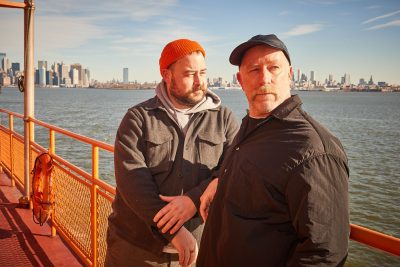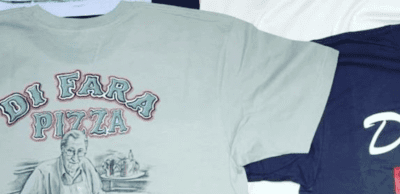Illustration by Jessica Ulman
Catching stripers with the Brooklyn Fishing Club
Fishing in (and around) the borough has seen a surprising pandemic boom over the course of the past year
Jeff Kessler is standing on a bank in Croton Point Park, a grassy peninsula 35 miles north of Manhattan, thumbing through pictures on his iPhone.
“You can tell a true fisherman by scrolling through their photos,” says Kessler, a real-estate agent from Crown Heights and seven-year veteran the Brooklyn Fishing Club, the largest and most active urban angling organization in New York City. He flashes a picture of himself on a boat, holding a turbot—an oblong, alien-looking flatfish—in each hand. Next, he pulls up a photo of himself on a dock, hands gripping the body of a striped bass. Then Kessler scrolls to a photo of himself with Victor Lucia, founder of the Brooklyn Fishing Club, reeling in trout at a reservoir north of Manhattan. “You’ll find more pictures of fish than their kids.”
It’s a sunny, brisk Saturday afternoon. About a dozen anglers—all members of the club, about half of them new—have lines in the water. Many sit in lounge chairs, five feet behind their fishing poles, which are held in place with rod holders, hammered into the soft earth. They trade beers and small talk. Lucia, tan and brawny, meanders among them. He offers tips and playful barbs. The day’s target is striped bass, a stout, spotted, silvery fish, now migrating back to the Hudson after spending the winter along the southern Atlantic coast. The tide is low and fish aren’t biting, but no one seems to mind.
A viral pastime
In the last year, the Brooklyn Fishing Club welcomed more than 200 new members into their ranks. This surge in membership tracks with a larger, nationwide trend. Fishing during the pandemic emerged as a popular pastime for people in search of a Covid-safe outdoor activity. In New York State, fishing license sales jumped nearly 10 percent between 2019 and 2020, and other states, from Minnesota (26 percent) to Vermont (50 percent) to Texas (19 percent) saw even bigger spikes. These licenses are usually sold online, but some are still purchased in local bait and tackle shops, like Bernies, which has operated in Sheepshead Bay for more than 70 years.
“This last year, given the fact that everybody was kind of landlocked, we did have a lot of new customers,” says Mike Giordano, the shop’s manager. “Fishing was a little bit of an escape route to get past the pandemic.”
The club’s newest members run the gamut. They are NYU Langone doctors, construction workers, after-school teachers and businessmen. There is no clear template, aside from gender—the vast majority of the club’s members are male—for who chose to pick up a rod during the pandemic.
“It’s the great equalizer,” says Kessler, pocketing his phone. “When people come out here it doesn’t matter what they’re posting on social media, whether you agree with it or not. People just want to talk about fish.”
When Lucia formed the club as a graduate student at Brooklyn College, he had just completed a school project that involved rounding up the city’s urban angling folklore. Through that process, he became aware of a number of niche fishing organizations, like the Staten Island Tuna Club and The Anglers Club of New York. Both were home to experienced fishermen, and he saw an opportunity to create something more egalitarian; a club where the only prerequisite was enthusiasm.
“I originally set out to make a club where as many people could meet each other as possible,” he says. “I would also say part of me started the club selfishly, just to meet other people to fish with.”
Seven years later, the Brooklyn Fishing Club’s Instagram has almost 26,000 followers, Lucia himself hosts a popular podcast, and the organization has won, to the chagrin of some within the fishing community, respected tournaments.
“We literally do everything in terms of fishing,” he says.
‘Do you actually catch fish here?’
To succeed as a fisherman requires a commanding knowledge of minutia, from understanding lure and bait types to making sense of tide charts. Clubs, for beginner fishermen, offer community and information. Lucia invites new members to a private Facebook group, where veteran anglers field questions and club outings are organized. They often schedule trips outside of the five boroughs to well-known spots like Croton—and, in the winter, to Lake George, for ice-fishing—but club members are more likely to be found in the city, casting from piers, docks, and into freshwater lakes. Popular destinations, like Harlem Meer in Central Park, can be found with a simple Google search. But other spots are fiercely guarded. Too many lines in the water means that any one fisherman is less likely to get a bite. The idea that a robust fishing scene exists in the city is a surprise for most people—and, every few years, the subject of an incredulous bit of journalism.
“More often than not, people who come up to me are curious, like, do you actually catch fish here?” says Kimberly Lee, a pharmacist and the club’s Manhattan Borough President, over the phone. “It’s totally understandable. I was one of those people too.”
Lee began fishing in 2015, several years after moving from New Jersey to New York. Her older cousin, who had spent years fishing the city’s waters, convinced her to join him for an outing. She accepted, and, like many first timers, found herself … hooked. The pair began to regularly venture to freshwater spots in Brooklyn, just to see what they could catch. “We would be like, hey, there’s a lake here, let’s see what’s there.”
Like many recreational fishermen, Lee posts her catches on social media. For anglers, platforms like Instagram and Facebook have made it easier to network and share photos, but they’ve also been a source of drama. In the past, members of the Brooklyn Fishing Club have been accused of “burning” spots—revealing secret fishing locations—which can lead to a digital fracas. But without social media, it’s possible that Lee would still be fishing alone (her cousin has since moved to Colorado, where he continues to fish). Through the Brooklyn Fishing Club’s Instagram, Lucia started leaving comments on her posts, and invited her to a club meeting. She was skeptical at first; fishing was her private hobby. But the next year she caved, and joined the club on an excursion in Sheepshead Bay.
“After that it was pretty much an avalanche effect,” she says. “I learned a lot about striper fishing, saltwater fishing, and met some really cool people who were very kind and took me shore fishing. It was a whole world and community that I felt lucky to have shared with me.
An unexpected bite
Over the phone, Lee tells me about a recent trip with two friends to a pier in Long Island City. In her bag were bloodworms, bunker chunks, and circle hooks—the rudiments for catching striped bass. Her expectations are tempered. The odds of catching a large striper this early in the season are slim. Most stripers currently in the river are “schoolies”—small fish, less than 2 years old. The larger fish migrate later in the season. Standing on the dock, Lee slipped a bunker chunk onto a circle hook and casts out.
“We were drinking, chilling on the pier, just talking with each other and catching up,” she says. “Then all of a sudden my rod bounces up and down.”
A bell attached to the tip of her fishing pole started ringing wildly. The reel “screamed,” the line unraveling at speed. She grabbed the rod and began to fight. For 10 or 15 minutes, she pulled the fish towards the dock, working methodically, trying not to let the fish slip the hook. “As it got closer to the pier we saw a sliver of white breaking the water,” she said. “At that moment everyone gasped, like, oh my god, that is a big fish.”
She reeled it close, and one of her friends, using the net, scooped the fish from the water. It was a massive striper. They quickly measured it—37 inches long, which qualifies, in fisherman’s parlance, as a “monster.” A crowd had gathered, and it watched as Lee, after snapping a quick photo, stepped over a barrier and down the pier’s rickety dock. She placed the striper back into the river, aimed in the direction of the current. It gave a little snap, then a larger one, then shot off, out of sight beneath the water.
View this post on Instagram
You might also like 


























